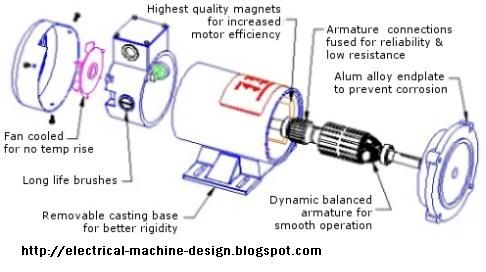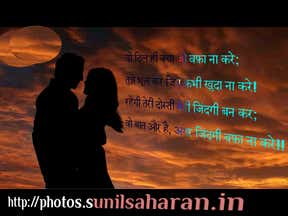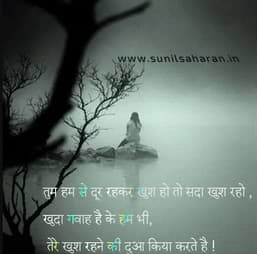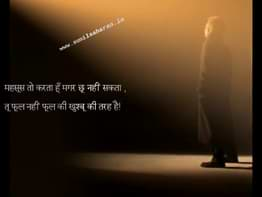Construction and Working of D. C. Machines
Written On Tuesday, December 1st, 2009 At 09:15:27 am By Sunil Saharan
23388 Times
This article explains how a DC Motor works. Basic constructional features of DC motor are also discussed in this article. So This article is about constructional features of a D. C. Motor. Here I will discuss importance of various constructional part of a D. C. Motor like function of stator, function of rotor and importance of commutator and brushes etc.
Hello Friends,
We have already studied D.C. Machines : Basics, Operating Modes & Applications and Types of D. C. Machines but before looking into the constructional features and constructional details of a D. C. Motor it is important to learn how a D. C. Motor works. Thus, here I am discussing some basics and brief description about how a D. C. Motor works.
(a). Permanent Magnet System
(b). Electromagnetic System
In both cases stator is essential.
Stator
A stator is outermost part of a D.C. Motor and it serve following purposes :
i. It provide mechanical support to the machine.
ii. It host magnetic field system as magnetic poles of main magnetic field are mounted on stator.
iii. Most importantly it provide path to magnetic flux with very small reluctance.
Main Field System
As I have already told main field system is of two types. In permanent magnet system, a permanent magnet is mounted on stator and in electromagnet field system an Inductor is mounted on poles on stator and a current is passed through this inductor to produce a magnetic field.
We have already studied D.C. Machines : Basics, Operating Modes & Applications and Types of D. C. Machines but before looking into the constructional features and constructional details of a D. C. Motor it is important to learn how a D. C. Motor works. Thus, here I am discussing some basics and brief description about how a D. C. Motor works.
Working of D. C. Motor
As we know that for rotation of an electrical machine two flux or two different magnetic field systems are essential. In case of D. C. Motor two types of field systems are used. There are- Permanent Magnet + Armature Winding System
- Electromagnet + Armature Winding Arrangement
Permanent Magnet System
In this type of arrangement a permanent magnet is placed across a conductor winding of copper wire. The winding is called armature winding and this winding is fed from a D.C. Supply system. The end point of the conductors of this winding are connected to a rotating system called commutator. The commutator is a mechanical rectifier and it convert supplied D. C. Power into A. C. and vice versa. The commutator rubs against a set of carbon pieces commonly known as the brushes. The brushes make electrical connection with commutator during its rotation, and the set of brushes are electrically connected to the positive and negative leads of the supply system. This type of arrangement allows electricity to flow through the armature winding. The electrical power flowing through the winding creates a magnetic field that interacts with the magnetic field of the permanent magnet mounted on stationary part of machine called stator and it makes the armature wise spin and finally spins the rotor where armature winding is hosted. This is the reason why almost all DC motors have armature winding on rotor and stationary windings or permanent magnet for field system on stator. There are some conductors at commutators which are named as commutator bars and there bars are soldered to armature coils to conduct the current to the coil or winding through the brushes. For basics see D.C. Machines : Basics, Operating Modes & Applications. At a given instant the commutator and brush arrangement magnetise a given part of the rotor and thus producing magnetic poles around that particular part. Which rotate that part forward and changing position of the rotor and thus changing position of part magnetised by armature winding and brushes-commutator arrangement. This makes the rotor or D. C. Machine rotates continuously.Construction of D. C. Motor
Now we have learned the working of a D. C. Motor so it is easy now to understand its construction. The main constructional parts of a D. C. Motor can be classified in three parts and these three are given below :- Main Magnetic Field and Supporting System
- Armature Winding and Supporting System
- Commutator and Brush Arrangement
Main Magnetic Field and Supporting System
As I told you there must be two separate magnetic fields to produce rotation in any electrical machine. The field system is used to produce main magnetic field. This arrangement may be of two kind :(a). Permanent Magnet System
(b). Electromagnetic System
In both cases stator is essential.
Stator
A stator is outermost part of a D.C. Motor and it serve following purposes :
i. It provide mechanical support to the machine.
ii. It host magnetic field system as magnetic poles of main magnetic field are mounted on stator.
iii. Most importantly it provide path to magnetic flux with very small reluctance.
Main Field System
As I have already told main field system is of two types. In permanent magnet system, a permanent magnet is mounted on stator and in electromagnet field system an Inductor is mounted on poles on stator and a current is passed through this inductor to produce a magnetic field.
Armature Winding and Supporting System
This system produce auxiliary field system or second field system. Armature winding is hosted on rotor, the rotating part mounted on a shaft and is placed in stator with small air gap.Commutator and Brush Arrangement
As I told above function of commutator is to magnetise particular part of the rotor and brushes help commutator to perform this function. The diagram shown below explain proper construction of a D. C. Motor.
Tags :DC Motor Construction, DC Motor Working, Principal of DC Motor
Article Was Last Updated on Monday, March 26th, 2018 At 01:14:17 am
Follow steps described here at your own risk. Privacy Policy
Those who had coins, enjoyed in the rain. Those who had notes, were busy looking for shelter.
Site Statistics
Stats at a Glance
Articles: 54
Viewed: 415739 Times
Photos : 53
Viewed: 583491 Times
Questions : 2344
Viewed: 387195 Times
Page Load No. 3401649
Photos
Take Quiz
1 Liners For Exam
Show Questions(1 by 1)
©2011-2023 SunilSaharan.In




